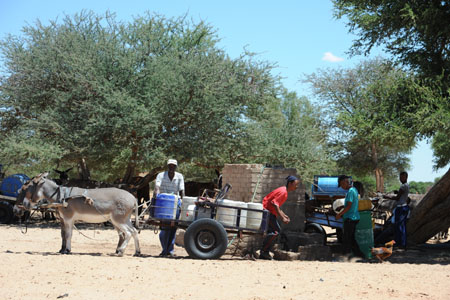A glimpse into Koinaphu Trust
23 May 2013
The search for the legacy of Koinaphu Trust unfolded into an unsavory roller-coaster in the scorching Kgalagadi temperatures.
There is not even a single signboard to give a clue about the existence of such community project. And even perusing through search engines was all flops and fumbles, as none of the information gathered provided a clear direction about the physical location of the trust, let alone details of any development projects undertaken.
After locating its chairperson at Inalegolo settlement, it became clear that the trust, which is made of the communities of Kokotsha, Inalegolo and Phuduhudu, is yet to find its footing in community development projects owing to budget constraints.
Koinaphu is an offspring of the Community Based Natural Resources Management (CBNRM) Policy, which attempts to influence conservation through community involvement. Communities would then benefit through setting up community based organisations (CBO) that will venture into commerce, create employment and promote conservation.
And Mr Dithupa Anena argues that even if economic generating opportunities are limited, communities must not lose focus on the environment. “We still have a duty to protect the environment, with or without money we have to be jealous of this environment,” he says.
Since its formation 13 years ago, Koinaphu Trust, at least according to Anena, played an insignificant role in changing the infrastructural landscape of the three settlements. “In the past we have managed to construct three standpipes for three destitute households from each of the three communities”.
The standpipes have remained the only three flagship projects that Koinaphu Trust has achieved, yet its chairperson is not worried at all. Though operating with neither office nor staff, Mr Anena takes solace in that residents of the three communities have been baptised into issues of environment and wildlife conservation through different forums.
Whilst some community organisations in the country handle millions and thousands of pula, Mr Anena is not alarmed by the state of affairs at Koinaphu accounts. “We have close to 90 camels and it is only a matter of time before they start generating income for us,” he says.
Though he could not account how the camels would generate income, Mr Anena contends that most of the community organisations dealing with millions rake money from quotas in their concession areas, while the situation is different in his area.
Although Koinaphu Trust’s NG 12 concession area has wild animals, the challenge he says, comes from the fact that most of the animals in the area are of less value. This has also been compounded by less tourism activities in the Kgalagadi area when compared to those in the northern western part of Botswana.
“We have come up with plans to revive the trust to generate more income, we are working on partnering with cooperative societies in our area,” he adds. However, the strategic partnership would be to woo an investor into their barren concession area NG 12.
“Another opportunity will be to venture into photographic tourism.” He says that would improve the finances of the trust even when government stops issuing quotas in the near future. “The trust will not collapse, it is still alive, we only need a turnaround strategy and find sustainable means of income generation,” he said.
His sentiments of hope are also shared by the Inalegolo Community Trust chairperson, Mr Bamotshwere Ghabite. “Our trust is not doing well, there is need to explore other opportunities in the area,” he opines.
According to him, the trust could promote cultural tourism in the area, in addition to game viewing which has not attracted many tourists to Kgalagadi. “The people of these three settlements share a common dream, the trust will not die,” he adds. ENDS
Source : BOPA
Author : Bonang Masolotate
Location : Inalegolo
Event : Interview
Date : 23 May 2013






